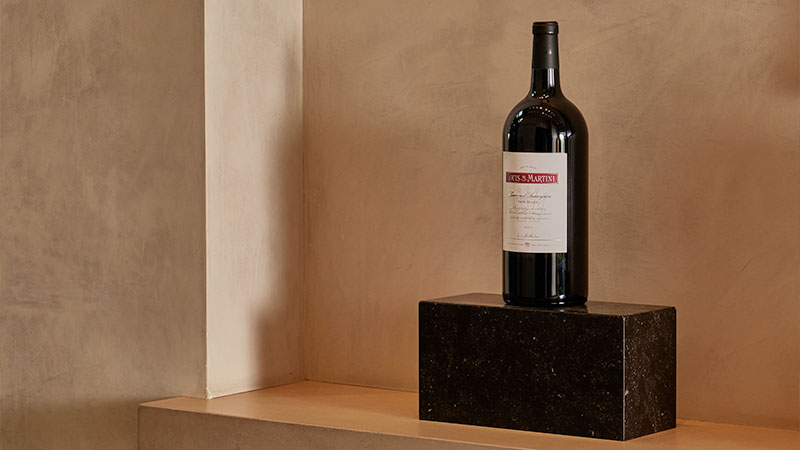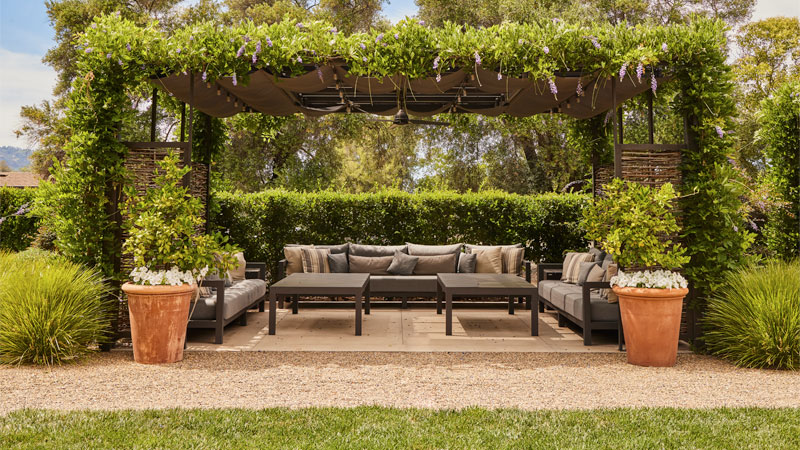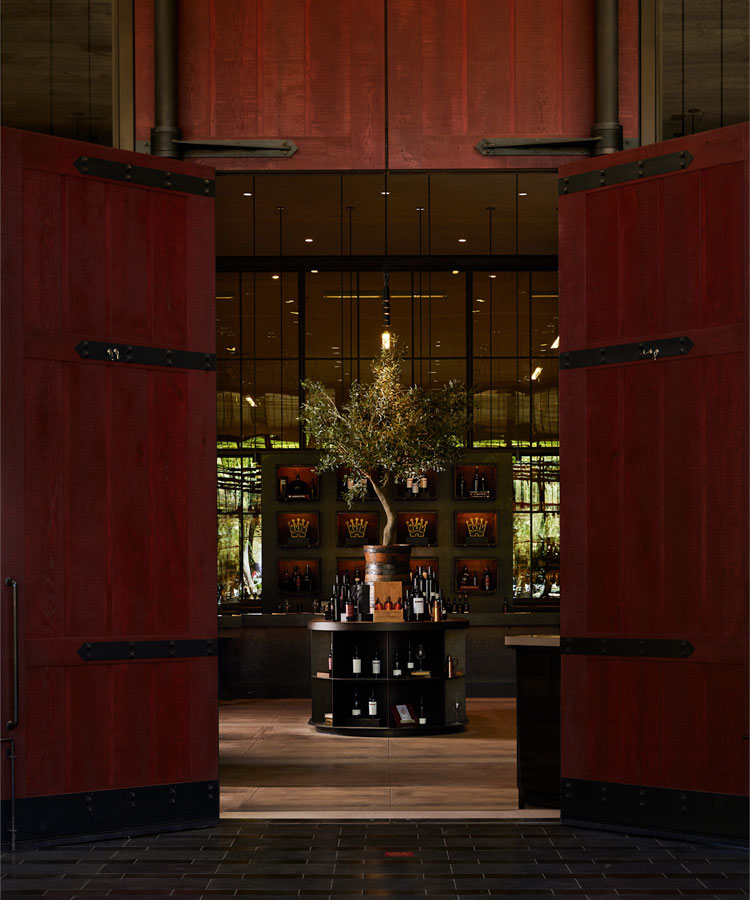
For anyone who loves Cabernet Sauvignon, Louis M. Martini is probably already a household name. Though you may be familiar with some of their bottles, there’s a whole other world within the winery in St. Helena in Napa Valley. Martini’s 80-year tradition of producing premier red wines means that there’s a lot of history and knowledge inside those walls — and it means there are quite a few surprises waiting for you in the winery.
“There’s a tremendous diversity of styles that you can craft from a single grape type: Cabernet Sauvignon,” says Michael Eddy, winemaker at Louis M. Martini. At the winery, he makes those Cabernets you might already be familiar with, but also more than a dozen varieties that come from some of the most sought-after vineyard sites in Napa, like Stagecoach Vineyard on Atlas Peak.
In addition to the Cabernets that are available nationwide, the winery offers a robust red selection from Martini’s historic Monte Rosso Vineyard, and small-batch reserve wines from single vineyards called the Crown Cabernet Collection.
“We’ve got 12 wines that we can guarantee no one’s familiar with unless they’ve been here,” says Quinn Martin, senior tasting room manager for Martini. “These wines are our hidden gems and most folks coming out to the property don’t know they exist.”
There are also a number of enticing ways to experience those wines at Martini, from an introductory wine tasting to a multi-course, multi-sensory event inside the underground wine cellar that’s filled with barrels dating back to the 1940s. The winery underwent an expansion and redesign in 2019, creating ample space for tastings, areas for four different kinds of food experiences, a winemakers classroom, and a gallery-style barrel room where visitors can watch the inner workings of the winery unfold.
“I’ve thought many times [about] what Louis M., our founder, would think if he was able to see what we’ve done,” Eddy says. “I always come to the conclusion that he would be extraordinarily proud. I really think we’ve done a fantastic job of keeping the original personality and spirit of the winery he built, but upgrading it to provide an elegant, elevated experience.” The walls still hold history – literally. During the renovation, Martini preserved the terracotta tiles from the original production facility and integrated them into the design of the new spaces.

A pioneer in Napa Valley wines, Louis M. Martini sold sacramental wine and wine concentrate for home winemaking during Prohibition, all while building his St. Helena winery in anticipation of the act being repealed. The very first day it became legal in 1933, Martini sold his first bottles of wine to the public. In the years after, Martini helped to establish the Napa Valley Vintners Association and implemented winemaking innovations, like cold fermentation, that are still standard practice today.
How Martini’s Legacy of Innovation Continues to Evolve
In Cellar 254, Martini’s winemaker’s playground, the winemaking team is able to experiment with wines in small batches to bring out the full expression of a vintage, controlling even the most minute variables to get the best result.
“They’re very small lots,” Eddy says. “Small tanks allow us to pick out very particular portions of blocks when they’re really at the peak of brightness. And as we get into the mountainsides where the vineyards are a bit more variable, that becomes a critical strength — to be able to really focus in and pick those few rows or that corner of the block that is at optimal ripeness.”
What comes from those batches is the Crown Collection, a group of single-vineyard Cabernets that regularly bring in ratings of 95 and 96 from Wine Advocate, as well as small-batch varieties like Petite Sirah and Gnarly Vine Zinfandel. Lot 1, the pinnacle of Martini’s portfolio, has been awarded 100 points by Robert Parker for its 2013 vintage.
Working in Cellar 254 in small batches “shows us what more we can do to make these wines even better and helps us discover what our next step will be when evolving the wine,” senior tasting room manager Martin adds. “We want to be able to show all of the steps in the practice of making wine that showcases the quality of fruit from the location, rather than emphasizing something we did to it.”
All the Ways to Taste for Yourself
On a first visit, you might start at the Crown Bar where wine tastings happen in full view of the barrel room. “We’ll walk people through the winemaking process for each of these wines,” Martin says. “[It] really help[s] people be introduced to a tier of our wines that most folks don’t know.” On another day, you might sit down in the Heritage Lounge, which showcases wines from the Monte Rosso Vineyard that Martini has owned for nearly a century.
There, chef Aaron Meneghelli creates a five-bite menu designed to highlight the nuances in those wines. A late spring pairing in the Heritage Lounge included pickled Napa Valley red and green strawberries with cocoa nib, radish, and basil; rabbit wellington with fennel and crème fraîche; a Nutella mille-feuille with hazelnut, dark chocolate, and blueberry, and more.
“First and foremost, we want to represent our seasons,” chef Meneghelli says. “Then I want to lean towards those Italian roots, those Mediterranean flavors. I think that melds extremely well with Napa Valley, but I’m also keeping in mind the roots are of the Martini family and trying to celebrate the old and the new at the same time.”
Outside, in Martini Park, the tastings focus on Cellar 254 wines and are casual, laid-back experiences that include an artisan culinary board. Within that area, there are private cabanas offering tastings where the chefs really get to let their creativity flow.

“There’s a lot of stuff that we can play with out there,” tasting room manager Martin says. “It allows our culinary team to show off all the different ways that we pair these wines. If you’re looking for an environment where you can relax and learn a little bit about the wines, but really just enjoy the environment, a cabana is the spot for that.”
For the true wine connoisseur — or the person who would like to become one — the Underground Cellar is a truly special experience.
“This is a full five-course wine and food pairing,” Martin says. Some of the wines poured that day will be current releases, and some will be library selections. “All of it is going to be what we internally would consider some of the best wines in the portfolio, not just for the structure and the style of production, but also for the age and the vintages being displayed.”
More than just a place to indulge in some of the finest wine and cuisine that Napa has to offer, the Underground Cellar serves as a calling card for days gone by. “You really are struck by the magic of this space,” winemaker Eddy says. “It just fills you with this emotional sense of history.”
Three generations of Martinis made wine at Louis M. Martini. Though the Martini family no longer owns the winery, their history and legacy are everywhere – in the grapes from the Monte Rosso Vineyard that the family planted in the 1930s, in the historic documents and family artifacts on display in the Crown Tasting Room, and in the enormous, historic wine barrels in the wine cave with those original terracotta tiles.
The result is both an homage to the past and a totally modern experience. It’s not dissimilar to sipping the Martini wines that are available in the tasting room. There’s history and wisdom in those bottles, but also an entirely fresh perspective, one that looks forward to the future of winemaking and what even-better expressions are on the horizon.
This article is sponsored by Louis M. Martini Winery.
